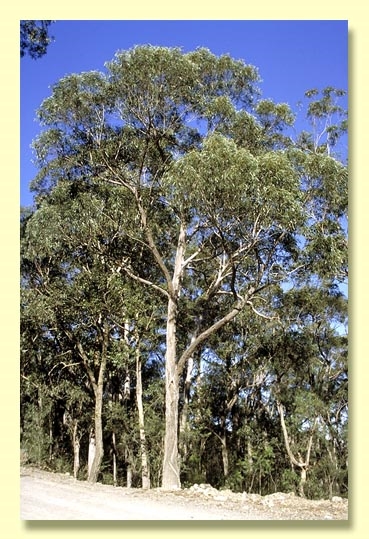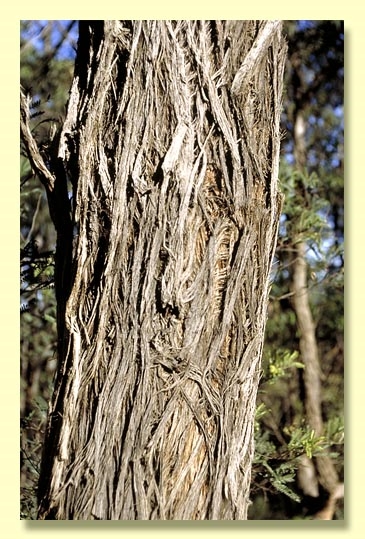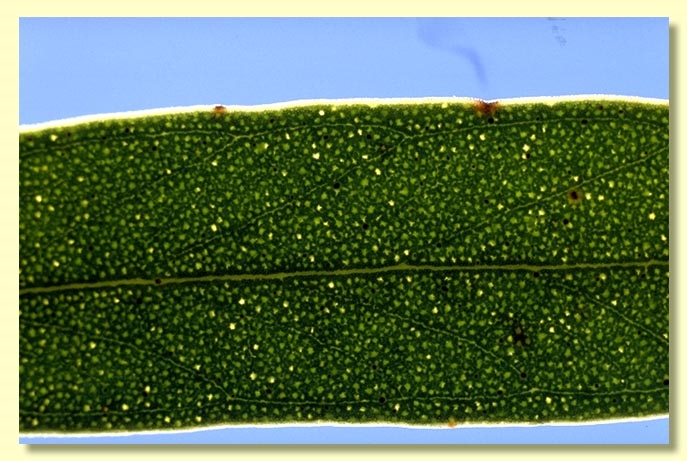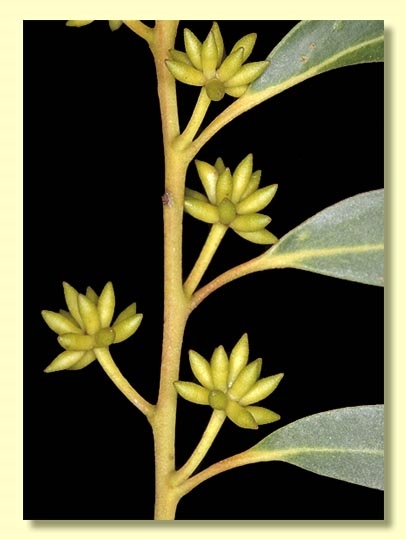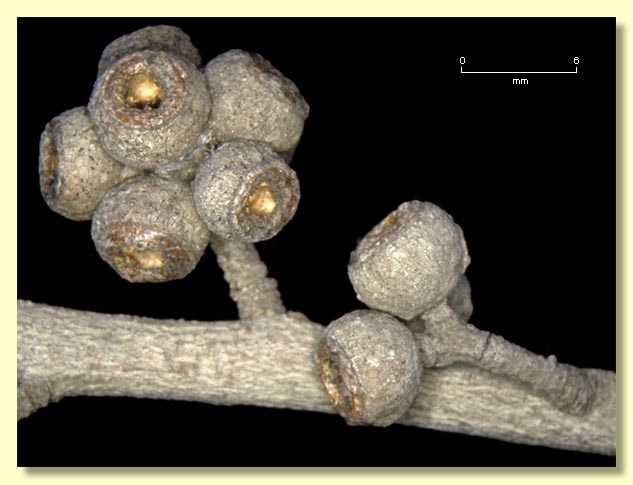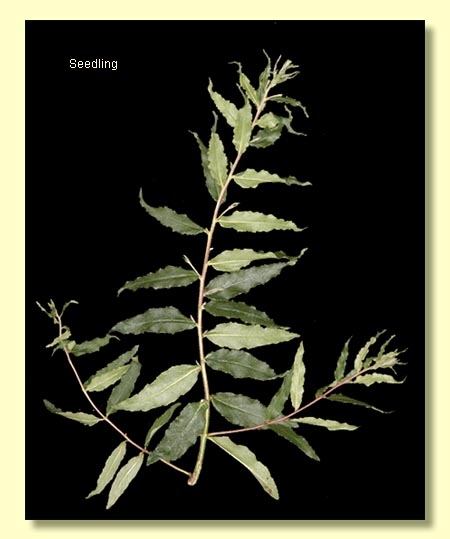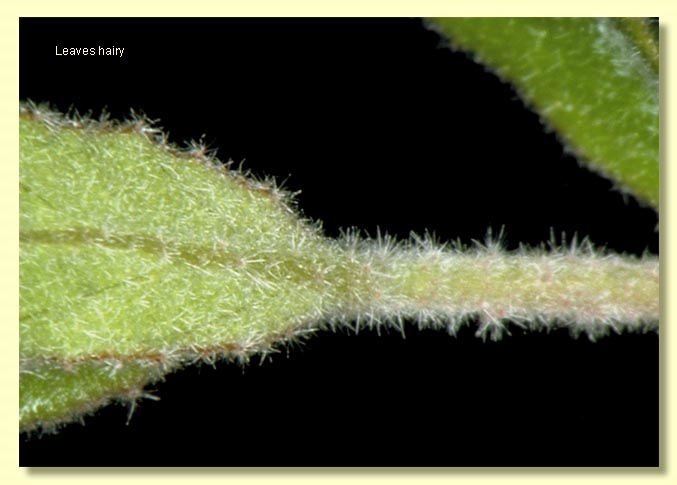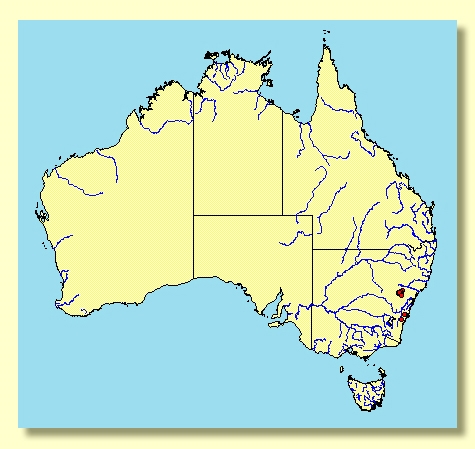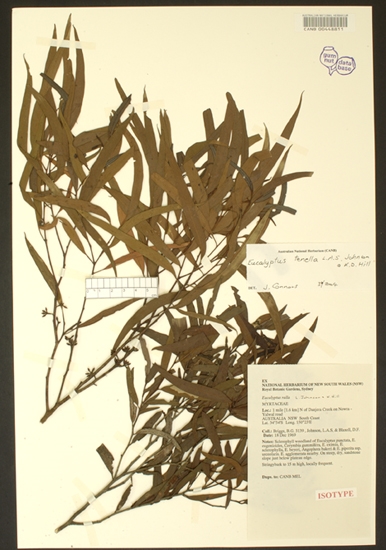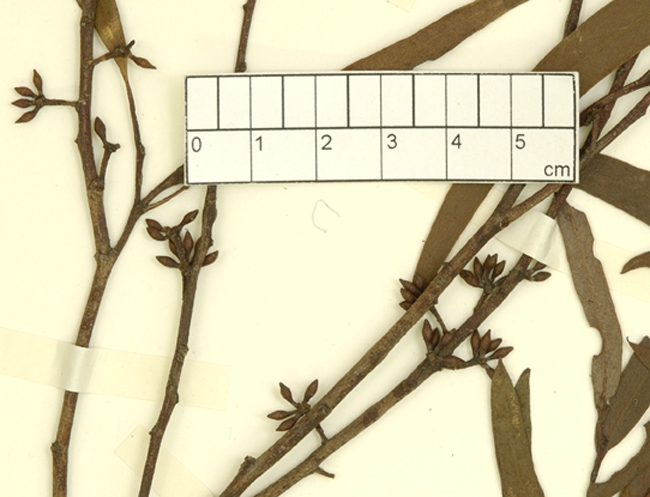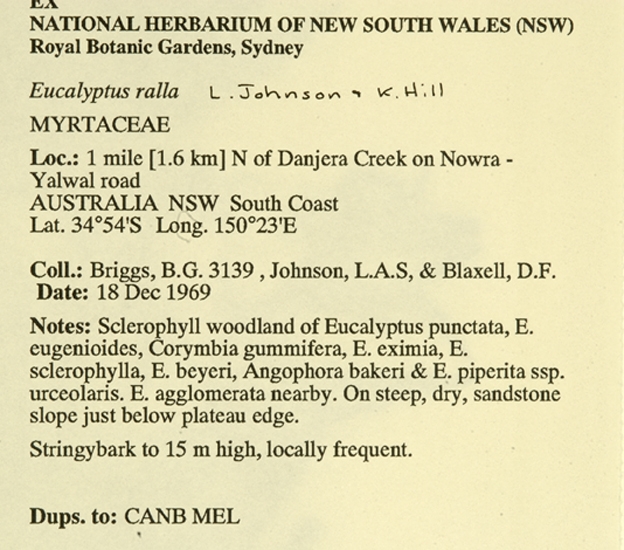Euclid - Online edition
Eucalyptus tenella
Eucalyptus | Eucalyptus | Capillulus | Pachyphloius
T: NSW, Central Tablelands, Capertee, 30 Sep. 1968, L.A.S.Johnson s.n.; holo: NSW.
Eucalyptus ralla L.A.S.Johnson & K.D.Hill, Telopea 4: 250 (1991). T: NSW, South Coast, 1 mile (1.6 km) N of Danjera Creek on Nowra - Yalwal road, 18 Dec. 1969, L.A.S.Johnson, D.F.Blaxell & B.G.Briggs 3139; holo: NSW; iso: CANB, MEL.
Bark rough to small branches, stringy, furrowed, grey to grey-brown.
Juvenile growth (coppice or field seedlings to 50 cm): stem rounded in cross-section, scabrid; juvenile leaves subsessile, opposite for 7 to 10 nodes then alternate, narrowly lanceolate to linear, 2.5–7 cm long, 0.3–1.5 cm wide, margin scabrid and irregular, sometimes markedly undulate, discolorous, glossy, green; new growing tips, stems, leaf margin and midrib scabrid until at least 0.5 m tall.
Adult leaves alternate, petiole 0.3–1.5 cm long; blade narrowly lanceolate to falcate or linear, 5–15 cm long, 0.5–2 cm wide, base oblique, concolorous, glossy, green, side-veins acute, sparsely reticulate, intramarginal vein parallel to and remote from margin, oil glands island.
Inflorescence axillary unbranched, peduncles 0.4–1 cm long, buds in umbels of 7 to 15, sessile or on pedicels 0.3 cm long. Mature buds ovoid to fusiform, 0.4–0.6 cm long, 0.2–0.3 cm wide, green, scar absent, operculum conical to rounded, stamens irregularly flexed, anthers reniform to cordate, versatile, dorsifixed, dehiscing by confluent slits, style long, stigma tapered, locules 3 or 4, the placentae each with 2 vertical ovule rows. Flowers white.
Fruit sessile or on pedicels to 0.3 cm long, truncate-globose to hemispherical, 0.3–0.5 cm long, 0.5–0.8 cm wide, disc slightly raised-convex, or level to slightly descending, valves 3 or 4, usually near rim level.
Seeds brown, 1.2–2 mm long, pyramidal or obliquely pyramidal, dorsal surface smooth, hilum terminal.
Cultivated seedlings (measured at ca node 10): cotyledons reniform; stems rounded in cross-section, densely stellate-hairy; leaves sessile to shortly petiolate, opposite for 3 to 10 nodes then alternate, lanceolate, 2.7–7.5 cm long, 0.5–2 cm wide, base rounded to tapering, margin irregular, discolorous, glossy, mid-green above, paler beneath, sparsely stellate-hairy above, more so below.
Flowering has been recorded in February, March, September and November.
A small to medium-sized tree of the central western slopes of New South Wales from the Rylstone–Capertee–Ilford area south-east to the Megalong Valley and Yalwal area west of Nowra. Eucalyptus tenella has rough stringy bark to the small branches, a glossy green crown, small ovoid to fusiform buds and globular hemisherical fruit 0.5–0.8 cm diameter. Juvenile growth is scabrid/hairy until ca 0.5 m tall and has linear or lanceolate leaves 0.3–1.5 cm wide.
Eucalyptus tenella is a stringybark belonging to the group with non-angular, ovate to fusiform buds and more or less sessile, crowded but non-deformed fruit without exserted valves, and is distinguished by the crown of narrow leaves. The narrow-leaved stringybarks of the Yalwal area were published as Eucalyptus ralla, but they are now included in E. tenella and differ mainly by having a narrower-leaved crown. Eucalyptus tenella is most likely to be confused with E. globoidea, which has similar fruit but differs in the juvenile leaves which are ovate and 2–4.5 cm wide (juveniles 0.3–1.5 cm wide in E. tenella ). Eucalyptus sparsifolia is also very similar in fruit features to E. tenella but differs in having even narrower linear juvenile leaves only 0.2–0.4 cm wide. E. eugenioides has ovate juvenile leaves > 1.5 cm wide and scabrid/hairy for many nodes.
The adult leaves of Eucalyptus tenella may have lenticels on the leaf edges giving the edge a distantly and shallowly toothed appeareance. In this character it has affinity with E. mckieana, a species endemic to the Northern Tablelands of New South Wales, and E. eugenioides.
MORE ABOUT STRINGYBARKS

